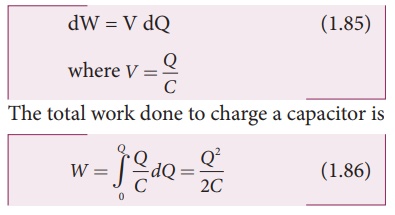Chapter: 12th Physics : Electrostatics
Energy stored in the capacitor
Energy stored in the capacitor
Capacitor not only
stores the charge but also it stores energy. When a battery is connected to the
capacitor, electrons of total charge -Q are transferred from one plate to the
other plate. To transfer the charge, work is done by the battery. This work
done is stored as electrostatic potential energy in the capacitor.
To transfer an
infinitesimal charge dQ for a potential difference V, the work done is given by

This work done is stored
as electrostatic potential energy (UE) in the capacitor.

where Q = CV is used.
This stored energy is thus directly proportional to the capacitance of the
capacitor and the square of the voltage between the plates of the capacitor.
But where is this energy stored in the capacitor? To understand this question,
the equation (1.87) is rewritten as follows using the results C=őĶ0A/d
and Ed

where Ad = volume of the
space between the capacitor plates. The energy stored per unit volume
of space is defined as energy density uE =U/Volume From equation (1.88), we get

From equation (1.89), we
infer that the energy is stored in the electric field existing between the
plates of the capacitor. Once the capacitor is allowed to discharge, the energy
is retrieved.
It is important to note
that the energy density depends only on the electric field and not on the size
of the plates of the capacitor. In fact, expression (1.89) is true for the
electric field due to any type of charge configuration.
Related Topics